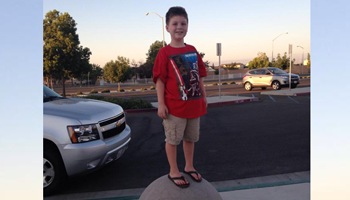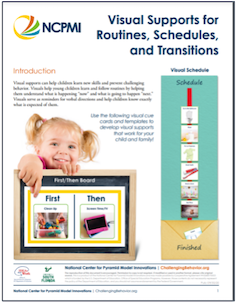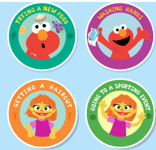
Visual Supports
“Gavin has been having a tough time this past week with the thought of going back to school. In fact, his little eyes have filled with tears a few times. This can definitely be a tough time for our little ones who are on the autism spectrum. So much change going on- new teacher, new classroom, new friends, new schedule…all things that make my Gavin nervous. As Brandon and I were talking with him this evening about starting first grade he started to get upset, saying that he didn’t want to go. It wasn’t until then that I thought about pulling out his visual schedule from last year. All I can say is wow! What a change in his attitude towards going to school! After going over his schedule, he was instantly excited and said he was ready to start first grade. So glad that my dude is at ease! Wish I would’ve pulled that out sooner!”
This true life story was shared with permission by Laurie Clark staff at WestEd CCFC. Gavin, her grandson, is a first grader included in a regular education classroom. Chelle is Gavin’s mom and Laurie’s daughter. Gavin’s story reminds us that social and emotional needs must be addressed and supported before any learning can take place.
- Tip Sheet: The Use of Visual Supports in Early Care and Education
- Using Visual Supports with Infants and Toddlers (PDF) This 11 page newsletter explains why and how to use visual supports and includes instructions on how to make them for use with infants and toddlers by child care providers and at home for families.
- 10 minute Podcasts on Use of Visual Supports: One for preschoolers and one for Infants and Toddlers
- Using Visual Supports with Young Children-Self Study Course
- The Connectability Visuals Engine
A tool that provides templates for you to create visual supports for your child with 1, 2, 4, 6, 12 or 16 images. You can use their library of photos or pictures or upload your own. It also provides tips on different ways that visuals can be used. - Connectability Visuals Tip Sheet


Children who have difficulties with social interactions often have trouble interpreting social situations and responding appropriately. The Head Start Early Childhood Learning & Knowledge Center (ECLKC) Social Stories™, developed by Carol Gray, help children understand the events and expectations in their lives.
The Head Start Center for Inclusion (HSCI) offers a library of one-page Social Stories™ that can be downloaded, printed out, and customized for immediate use. Teachers and parents may also use these as a template to write their own stories that meet a child’s individual needs.

Visual Supports for Routines, Schedules, and Transitions (PDF)
Visual supports can help children learn new skills and prevent challenging behavior. Visuals help young children learn and follow routines by helping them understand what is happening “now” and what is going to happen “next.” Visuals serve as reminders for verbal directions and help children know exactly what is expected of them.
Transition Visual Cards (PDF)
Transitions occur when children move from one activity to another. For some young children, moving from one activity to another (e.g., bus to classroom, centers to circle time, art time to lunch) results in confusion, frustration, and/ or challenging behaviors. Planning for transitions includes developing routines and teaching children what to expect during the transition. Transition routines help to prepare children for transitions, engages them in the change that is taking place, and helps them to move smoothly to the next activity. When children are able to participate in or lead the transition, they are excited and eager to move to a new activity. The more children can predict and participate in the schedule and activities of the day, the less likely it is that challenging behavior will occur and the more likely it is they will engage in transitions.
